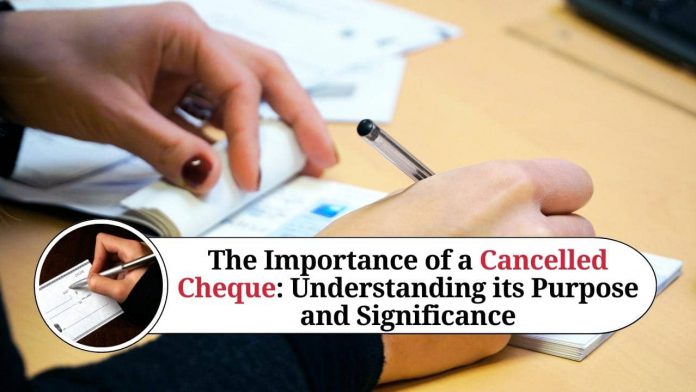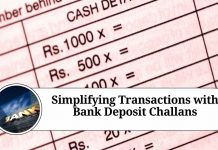A cancelled cheque is a document that serves as proof of both the existence of a bank account and the account holder’s identity. This simple piece of paper can be used for various financial transactions, from opening a fixed deposit to applying for a loan. In this blog, we’ll explain what a cancelled cheque is, its various uses, and why it is important.
What is a Cancelled Cheque?
A cancelled cheque is simply a cheque that has been used and cleared by the bank. When a cheque is written, it is deposited into the payee’s account, where it is then processed and cleared. Once the cheque has been cleared, it becomes a cancelled cheque.
Uses of a Cancelled Cheque:
A cancelled cheque can be used for several purposes, including:
- Proof of Bank Account: A cancelled cheque serves as proof of the existence of a bank account, which is necessary for several financial transactions.
- Proof of Identity: The name and address printed on the cheque, along with the bank’s stamp, serve as proof of the account holder’s identity.
- Loan and Credit Applications: Banks and financial institutions often require a cancelled cheque to verify the applicant’s bank account and identity before processing a loan or credit application.
- Direct Deposits: Employers often require a cancelled cheque to set up direct deposits for payroll and other payments.
- Fixed Deposits: A cancelled cheque is often required when opening a fixed deposit to verify the account details and ensure that the deposit can be credited to the correct account.
Why is a Cancelled Cheque Important?
A cancelled cheque is a critical document for several reasons, including:
- Verification: It provides verification of the account and account holder’s identity, which is essential for financial transactions and for protecting against fraud and scams.
- Convenience: A cancelled cheque is a convenient way to provide proof of account and identity, as it eliminates the need to provide additional documentation.
- Trust: Banks and financial institutions accept cancelled cheques as proof of account and identity because they trust the security and verification processes used by banks.
How to Obtain a Cancelled Cheque?
Getting a cancelled cheque is a straightforward process, and there are several ways to obtain one, including:
- Writing a Cheque: The easiest way to get a cancelled cheque is to write a cheque and deposit it into your account. Once the cheque has been processed and cleared, it becomes a cancelled cheque.
- Requesting from the Bank: You can also request a cancelled cheque from your bank. Most banks will provide a cancelled cheque upon request, although they may charge a fee for the service.
- Digitized Image of a Cancelled Cheque: Some banks offer the option of providing a digitized image of a cancelled cheque, which can be used for the same purposes as a physical cancelled cheque.
It is important to note that banks typically only provide cancelled cheques for personal accounts and not for business accounts. If you need a cancelled cheque for a business account, you should contact your bank to see what options are available.
Read Other Useful Blogs:
Importance of Accurate Information on a Cancelled Cheque
It is critical to ensure that the information on your cancelled cheque is accurate, up-to-date, and consistent with other personal and financial documents. Incorrect or outdated information can cause problems and delays in financial transactions, and may even result in rejected transactions.
Here are some key pieces of information that should be accurate and consistent on your cancelled cheque:
- Account Holder Information: The account holder information on the cancelled cheque should match the information on your bank account and other personal and financial documents. This includes your name, address, and contact information.
- Bank Information: The bank information on the cancelled cheque should match the information on your bank account and other financial documents. This includes the bank name, branch address, and account number.
- Signature: The signature on the cancelled cheque should match the signature on your bank account and other financial documents. It is important to sign the cancelled cheque in a way that is consistent with your signature on other documents.
It is also important to regularly review and update the information on your cancelled cheque to ensure that it remains accurate and up-to-date. If you make any changes to your personal or financial information, such as a change of address, be sure to update your cancelled cheque and other relevant documents as well.
Security of Cancelled Cheques
Cancelled cheques contain sensitive information, including the account holder’s name, address, and bank information, which could be used for fraudulent purposes. It is essential to keep cancelled cheques safe and secure to protect against fraud and identity theft.
Here are some tips for keeping your cancelled cheques secure:
- Store in a Safe Place: Keep your cancelled cheques in a safe and secure place, such as a locked cabinet or safe.
- Destroy Old Cheques: Once you no longer need a cancelled cheque, it is a good idea to destroy it. You can do this by tearing it into small pieces or shredding it.
- Use Secure Transmission Methods: If you need to send a cancelled cheque, it is best to use secure transmission methods, such as registered mail or a secure online platform.
Digital Alternatives to Cancelled Cheques
In today’s digital age, many financial transactions can be performed without the need for a physical cancelled cheque. Here are some digital alternatives to cancelled cheques that you can use for various financial transactions:
- Bank Statement: A bank statement is an electronic or physical record of all the transactions that have taken place in your account over a specific period of time. A bank statement can serve as proof of account and identity for many financial transactions and can be obtained from your bank.
- Electronic Funds Transfer: Electronic funds transfer (EFT) is a convenient and secure way to transfer funds from one account to another without the need for a physical cheque. EFT is widely accepted and can be used for many financial transactions.
- Digital Payment Platforms: Digital payment platforms, such as PayPal and Venmo, are widely used for sending and receiving payments. These platforms can be used for many financial transactions and can serve as proof of account and identity.
- Mobile Banking: Many banks now offer mobile banking services, which allow you to perform financial transactions on your smartphone or tablet. Mobile banking can be used for many transactions and can serve as proof of account and identity.
Conclusion
In conclusion, a cancelled cheque is a simple but important document that serves as proof of both the existence of a bank account and the account holder’s identity. From loan and credit applications to direct deposits, a cancelled cheque is a necessary piece of documentation for many financial transactions.
Read Other Useful Blogs:
It is crucial to keep cancelled cheques safe and secure, as they contain sensitive information that could be used for fraudulent purposes. By obtaining a cancelled cheque, safeguarding it, and using it appropriately, you can ensure that your financial transactions run smoothly and securely.
Frequently Asked Questions (FAQs)
- What is a cancelled cheque?
A cancelled cheque is a cheque that has been deposited into a bank account and processed, which then becomes a record of the account holder’s bank information.
- Why do I need a cancelled cheque?
A cancelled cheque is often required as proof of bank account information for various financial transactions, such as setting up automatic bill payments or direct deposit.
- Can I get a cancelled cheque from my bank?
Yes, you can request a cancelled cheque from your bank. Some banks may charge a fee for this service.
- Can I get a digitized image of a cancelled cheque?
Some banks offer the option of providing a digitized image of a cancelled cheque, which can be used for the same purposes as a physical cancelled cheque.
- What information should be on a cancelled cheque?
A cancelled cheque should contain the account holder’s name, address, bank name, branch address, account number, and signature.
- How do I keep my cancelled cheque secure?
It is important to keep your cancelled cheque in a safe and secure place, such as a locked cabinet or safe. Once you no longer need the cheque, it is a good idea to destroy it.
- Are there digital alternatives to cancelled cheques?
Yes, there are digital alternatives to cancelled cheques, such as bank statements, electronic funds transfer, digital payment platforms, and mobile banking.
- How can I ensure that the information on my cancelled cheque is accurate?
It is important to regularly review and update the information on your cancelled cheque to ensure that it is accurate and up-to-date.
- Can I use a cancelled cheque for other financial transactions besides setting up automatic bill payments and direct deposit?
A cancelled cheque can be used for various financial transactions, but it is important to check with the relevant financial institution or lender to determine which forms of proof of account and identity are accepted.
- What should I do if I need to make changes to the information on my cancelled cheque?
If you need to make changes to the information on your cancelled cheque, it is important to contact your bank and request an updated cheque. You should also update other relevant personal and financial documents with the new information.




















